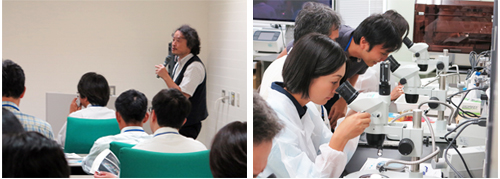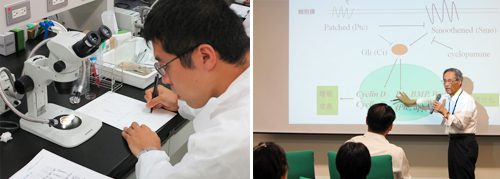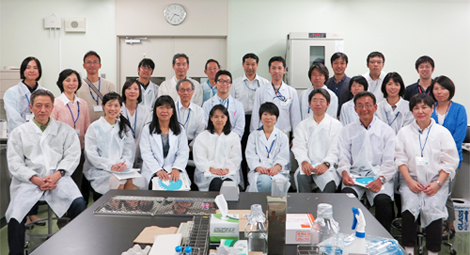
News and Announcements from the CDB
The annual two-day practical developmental biology course for high school science teachers was held at the RIKEN CDB on October 4–5. The course was co-organized with the Japanese Society for Developmental Biologists (JSDB) with the aim of contributing to high school science education by teaching classroom experiments to area science teachers. Approximately 20 teachers participated in this year’s course, which is in its seventh year.

On the first day, the CDB’s Shigeru Kuratani (Group Director, Laboratory for Evolutionary Morphology) gave a lecture in the morning on the evolution of the turtle, introducing the evolutionary process of how the turtle acquired its carapace through comparisons of development and gene expression. In the afternoon, course instructor Yasuo Ishii (Assistant Professor, Kyoto Sangyo University) led the practical program, which focused on the theme of development and cell differentiation. The science teachers first learned how to culture and observe the developmental stages of chicken embryos, and also how to prepare primary cell cultures from embryos, all of which can be carried out in a typical high school classroom.

During the morning of the second day, Sadao Yasugi (Professor Emeritus, Tokyo Metropolitan University) gave a seminar on the roles of genes during development using formation of the digestive system as an example. He explained how different areas of the digestive system acquire their distinct features and also touched on the history of concept of genes in developmental biology and how genes are introduced in high school education. The rest of the day was spent in the laboratory looking at primary cell cultures prepared the previous day under a microscope, trying to determine the morphology and features of each cell type (brain, retinal, heart, liver, and skeletal muscle). The retinal and liver cell cultures were used in a later experiment, which examined effects of the loss of cadherin function on cell-cell adhesion by depleting calcium ions from the culture medium (cadherin function is calcium-dependent). Many of the participants were surprised to see how quickly the cells began to dissociate from one another when calcium was removed. The course also included a demonstration by Yoshina Usui, a teacher at Hyogo Prefectural Suma High School, on how to use quail embryos in the classroom for observation and simple experiments looking at changes to heart rates.

The participants in this course have the opportunity to apply what they have learned here by serving as teaching assistants for a similar program organized for high school students in December.